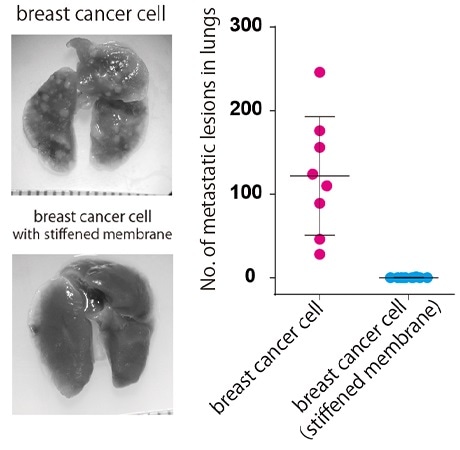When compared to the membranes of normal cells, the cancer cell membranes are more pliant. A research collaboration has found that cancer invasion and migration in mice can be inhibited by controlling the stiffness of the cell membrane.

By stiffening cancer cell membranes, metastasis can be suppressed in mice. Image Credit: Kobe University.
The research team included Lecturer Kazuya Tsujita and Professor Toshiki Itoh from Kobe University’s Biosignal Research Center, as well as Lecturer Reiko Satow and Professor Emeritus Kiyoko Fukami from Tokyo University of Pharmacy and Life Sciences.
The researchers believe that the study results can be applied for developing innovative cancer treatments that leverage the physical characteristics of cells. The findings were reported in Nature Communications on October 11th, 2021.
Research background
Metastasis is the key cause of deaths associated with cancer. With the increase in the malignancy of a cancer cell, it experiences amoeba-like structural changes that allow it to migrate very easily. It shifts away from the main lesion and induces distant metastasis.
Recent research has shown that these crucial changes to motility and cellular structure are governed by the physical characteristics of the cell itself. Indeed, it has been found that cancer cells are relatively “soft” than normal cells.
The link between changes in the physical characteristics of a cell and its malignancy has gained wider attention. But it is not known precisely which physical characteristics are associated with the cancerous nature of a cell.
Research findings
Tsujita and colleagues used optical tweezers in their study to pull the cell surface membrane and investigate it. This allowed them to identify that cancer cells are relatively softer compared to normal cells.
The cell membrane’s firmness is governed by the actin cytoskeletal networks that bind to it. This research showed that the ERM proteins that regulate this membrane-actin attachment in cancer cells are dissociated from the cell membrane, making the membrane soft.
The researchers securely attached ERM proteins to cancer cell membranes and could thus restore the membrane-actin attachment to make it resemble that of a normal cell. This made the cancer cell membrane stiffen and avoided abnormal changes in structure and motility.
Moreover, breast cancer cells featuring stiffened membranes lost the potential to move to the lungs in experiments performed with a mouse model. These findings show that it could be viable to restrict the spread of cancer by controlling cell membrane tension.
Further developments
The results of this study could enable the development of new cancer treatments that leverage the physical characteristics of cancer cells. Upon finding the chemical compound that stiffens cell membranes, it might be feasible to use it in effective medication to inhibit cancer invasion and migration.
Source:
Journal reference:
Tsujita, K., et al. (2021) Homeostatic membrane tension constrains cancer cell dissemination by counteracting BAR protein assembly. Nature Communications. doi.org/10.1038/s41467-021-26156-4.